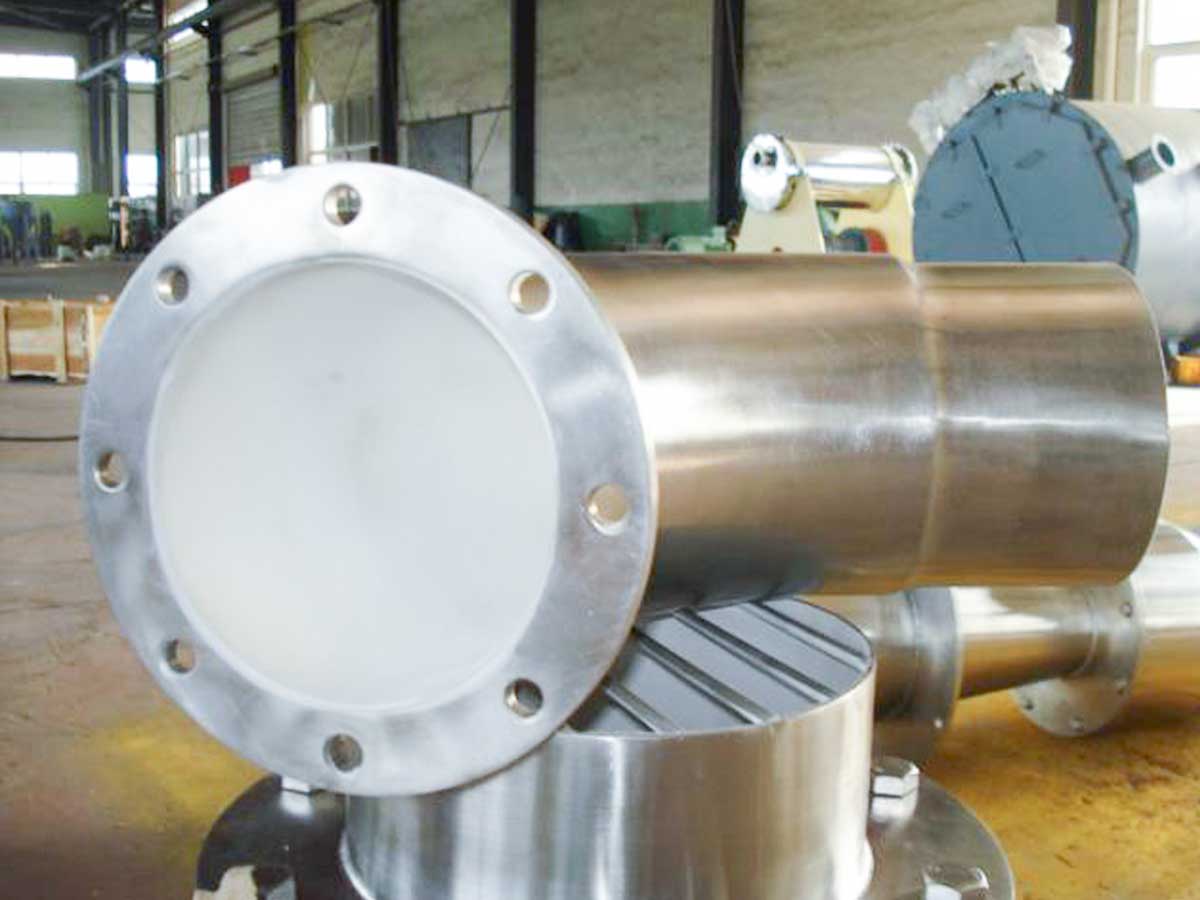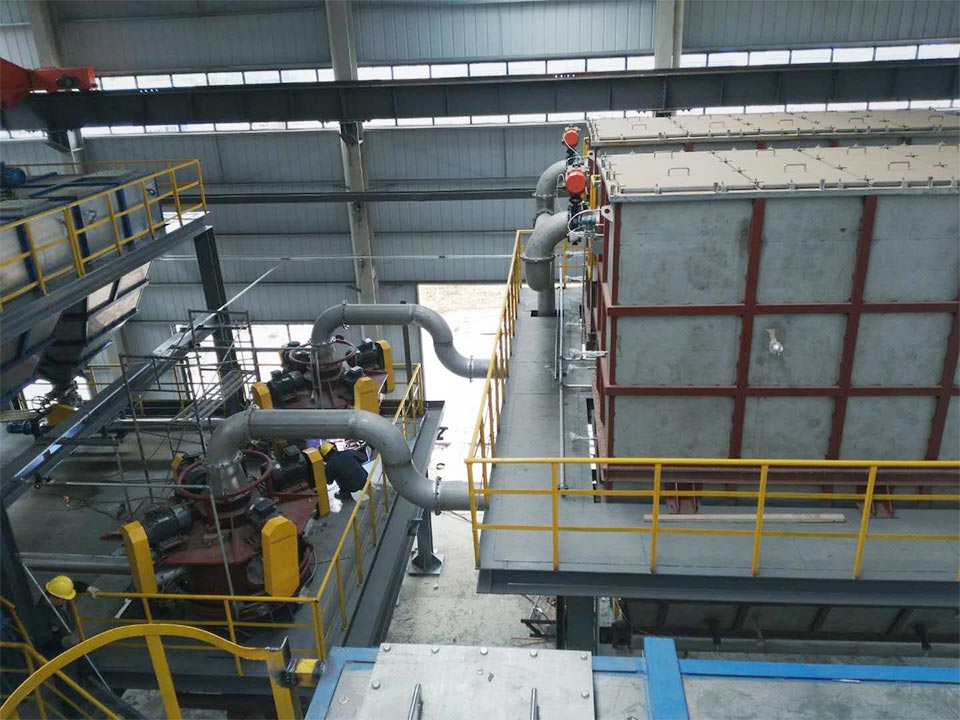Maintenance of jet mill classifier
The jet mill adopts the advanced structure of similar products at home and abroad, and is updated and improved on the basis of the Raymond mill in the same industry. This equipment has higher efficiency than ball mills, lower power consumption, smaller footprint, and small one-time investment. The jet pulverization classifier is a kind of equipment that uses high-speed airflow to achieve ultrafine pulverization of dry materials. The jet pulverization classifier is composed of a pulverizing nozzle, a grading rotor, and a screw feeder. The jet pulverizing classifier, cyclone separator, dust collector, and induced draft fan constitute a complete pulverizing system.

After the compressed air is filtered and dried, it is sprayed into the crushing cavity at high speed through the nozzle. At the intersection of multiple high-pressure airflows, the materials are repeatedly collided, rubbed, and sheared to be crushed. The crushed materials move with the ascending airflow under the action of the fan's suction. In the classification area, the coarse and fine materials are separated under the strong centrifugal force generated by the high-speed rotating classification turbine. The fine particles that meet the particle size requirements are collected by the cyclone separator and dust collector through the classification wheel, and the coarse particles drop to the crushing area and continue to be crushed. The jet mill classifier is widely used in industries such as chemical industry, minerals, metallurgy, abrasives, ceramics, refractory materials, medicine, pesticides, food, health products, new materials and so on.
The jet pulverization classifier is an air flow classification technology with a square cylindrical structure as the main body. This technology changes the form of the circular cylinder rotating air field, which makes the material more dispersible, thereby improving the classification efficiency. The jet pulverizing classifier adopts a high-precision horizontal classification form, which has a sharp cutting effect, good cutting accuracy and large particle control performance. The jet pulverizing classifier also adopts the connection form of the classifying wheel hinge structure, which can remove the classifying impeller, making it very convenient for gap adjustment and maintenance. It embodies the humanized design concept.
Air jet pulverizer classifier needs maintenance after working for a period of time to extend its service life and create more benefits for manufacturers. The jet pulverizing classifier can be maintained through the following four aspects:
(1) When cleaning the jet mill classifier, the motor and bearing seals should not be wetted with water.
(2) When replacing parts or repairing and maintaining the jet mill classifier, it should be carried out in the power-off state, and warning signs should be hung up.
(3) The bearings should be lubricated.
(4) Lubricating oil must be added after the general jet pulverizing classifier has worked for 1500 hours.
Precautions & maintenance steps before assembling the grinder
The shredder should be cleaned before assembly to ensure that the surface is clean. Pay attention to the cleanness of the ring die. If the material of the ring die of the screw hole is not clear, the ring die bolt hole is likely to be broken when the bolt tightens the ring. It is hoped to use a torque wrench to tighten the ring die to ensure the specified tightening torque.
Generally speaking, the new mold that matches the new roller, the ring mold and the old mold use the old roller, and each partial gap between the rollers is roughly the same. Therefore, the entire ring mold loading and unloading uniform can improve production efficiency. When assembling the roller, pay attention to the inspection of the bearing. If damage is found, it should be replaced in time. After the roller is assembled, make sure that there is a certain gap so that the roller can rotate freely. The transfer roller must be oiled on time. Once the roller lacks oil, it will cause the bearing and pressure roller to burn, and in severe cases, the entire roller will be scrapped.
And pay attention to before work, check the transmission parts, meters, valves, filling lubricating oil, and remove iron. The maintenance of carbon steel ring molds is more cautious.
1. The fixed operation of the crusher should be fixed on the cement foundation. If you change the work place frequently, the shredder and the motor should be installed on the base made of angle iron. If the pulverizer is powered by a diesel engine, the power of the two should be matched, that is, the power of the diesel engine is slightly greater than that of the pulverizer, and the pulley grooves of the two should be consistent. The outer end surface of the pulley should be on the same plane.
2. Before starting up, check whether the connecting bolts of each part of the unit are tight, whether the tightness of the transmission belt is appropriate, and whether the power cord is in good condition. Whether the motor shaft and the shredder shaft are parallel.
3. Check whether the hammer is in good condition, the aperture of the sieve is suitable, and whether it is damaged. Drag the belt by hand to check whether the spindle rotates flexibly, whether it is stuck, bumped, or rubbed.
4. After starting the machine, let the equipment run idling for 2-3 minutes to check whether the rotation of the rotor is correct and whether the sound is normal. It can work only after it rotates smoothly at the rated speed.
5. Pay attention to the operation of the crusher at all times during work, and feed evenly to prevent blocking the car, and do not overwork for a long time. If there are vibrations, noises, excessive temperature of the bearing and the body, or spraying materials, you should stop and check immediately, and then continue to work after troubleshooting.
6. The crushed materials should be carefully inspected, and no foreign objects such as stones, metals, etc. should be mixed to avoid damage to the machine.
7. When the machine is running, the operator is not allowed to leave the unit, nor is it allowed to disassemble the machine during operation to observe the working conditions in the crushing chamber, and the maintenance tools must not be placed on the machine or packing.
8. Operators should not wear gloves. When blockage occurs, it is strictly forbidden to reach into the filler hopper. When feeding, stand on the side of the grinder to prevent rebound debris from hurting the face.
9. Don't stop the machine immediately after the work is over, it should be idling for 2-3 minutes to allow the material in the machine to be discharged completely. Cleaning and maintenance work should be carried out after shutdown.
10. Hammers are the main wearing parts. After wear, the whole set of hammers must be replaced at the same time whether the edges and corners are changed in the same direction or the corners are changed. When replacing new hammers, the whole set of hammers must be replaced at the same time. Trade new for old. The sieves are also vulnerable parts. If part of the sieves are damaged, they can be riveted. If they are severely damaged, new sieves need to be replaced.
11. After 300 hours of operation of the crusher, the bearings should be cleaned and the oil should be replaced. When parking for a long time, the belt should be removed.
The air classifier can accurately classify metal powder
The rapid development of 3D printing has been widely used in our real life. The production of metal powder is a very critical part, but it is often overlooked. For high-quality special metals with superior mechanical properties required in the industry, alloy metal powders are showing an increasing trend. Airflow classifier is a common equipment in metal powder processing, and it is also a more important equipment. Only qualified finished metal powders screened by the airflow classifier can be put into application.

The metal powder air classifier is a classifying system composed of a classifier, a dust collector, and an induced draft fan. Under the action of fan suction, the material moves at high speed from the lower end of the classifier to the classification area with the updraft. Under the action of the strong centrifugal force generated by the high-speed rotating classification vortex, the coarse and fine materials are separated, and the fine particles that meet the particle size requirements are classified. The gap between the wheel blades enters the cyclone separator or the dust collector to collect, the coarse particles entrained by the part of the fine particles hit the wall and the speed disappears, and they descend along the cylinder wall to the secondary air outlet. After the strong elutriation of the secondary air, the coarse and fine particles are separated. The particles rise to the classification zone for secondary classification, and the coarse particles fall to the discharge port for discharge.
Equipment performance characteristics of metal powder air classifier:
1. It does not need to be washed with water or water, and it is produced by completely dry method, which can obtain a narrower particle size distribution and non-polluting abrasive powder; one grade can be processed into products of any brand according to the current domestic and foreign standards (such as: national standard W63~W3.5, Japanese standard 240#~3000# and European standard F230/53~F1200/3). The single number finished product rate reaches more than 75%.
2. The classification accuracy is high, the cutting particle size is more accurate, the required speed is lower, and the service life is long.
3. Independent casting bearing seat, never deformed, and long service life.
4. Optimized transmission design, small bearing force and long service life.
5. Unique piping design helps powder flow, helps reduce abrasion, and easy-to-wear parts are easy to replace and handle.
6. The unique frequency conversion feeding system is helpful for the dispersion of materials, can ensure the continuous uniformity and stability of the feeding, and is helpful for the control of product particle size.
7. Unique internal circulation secondary air design, adjustable grading cone gap, greatly reduced air consumption, lower grading energy consumption, and thorough extraction of fine powder.
8. The separation of the flow path helps to slow down the abrasion at the bottom of the classification wheel and is more conducive to the control of large particles.
9. Fully enclosed negative pressure operation, no dust pollution.
10. Good stability, stable production after adjusting the fixed parameters once;
11. In particular, the core competitive advantage of more thorough extraction of fine powder and good stability has been widely recognized by the industry.
12. The whole system adopts automatic control, which can realize one-button start and stop, and the operation is simple and convenient. The connection with the central control can realize remote control.
- General application:
It can classify materials that cannot be classified on ordinary sorting equipment. It is especially suitable for processing products that strictly limit the largest particle size and require a narrow particle size distribution, such as heavy calcium, kaolin, talcum powder, barite powder, copier toner, paint, Mica, graphite, auxin, aluminum hydroxide, etc.
- High-purity applications:
It can classify materials with extremely strict impurity content or materials that are extremely sensitive to iron, while meeting the requirements of particle size and particle size distribution. Typical materials are: fluorescent powder, titanium dioxide, starch, silica gel, aluminum, copper, luminescent powder and various high-purity pigments.
- Abrasive and hard materials:
The application of the vertical eddy current classifier can exceed the subdivision level of hard materials with a Mohs hardness level of seven or more, so that the wear of the equipment is extremely small. The rotating speed of the grading wheel can be adjusted, and the crushing parameters can be optimized. The combination of multiple classifiers can complete narrow-band classification of several particle sizes at one time. Typical products are: diamond, silicon carbide, boron carbide, tungsten carbide, special ceramics, emery and so on.
- Food, health products, medicine:
It can superfinely process the raw materials of medicine, food and health care products. Its low-temperature pulverization, high-purity operation, high processing finish and easy cleaning of the machine are ideal for use in the pharmaceutical, health care and food industries, which not only improves the bioavailability of medicines. And curative effect, and reduce production cost. Typical products are: pollen, hawthorn, shiitake mushroom, pearl powder, stomach medicine, nimodipine, antibiotic medicine, contrast medicine, Ganoderma lucidum, gallnut, fleece-flower root, etc.
Analysis of Principle and Characteristics of Quartz Ultrafine Jet Mill
Quartz sand is an important industrial mineral raw material, widely used in glass, casting, ceramics and refractory materials, metallurgy, construction, chemical industry, plastics, rubber, abrasives and other industries. Quartz sand is a kind of quartz particles produced by crushing quartz stone, which is a difficult raw material to process in non-metallic minerals. The strong representative material in mineral crushing is quartz, which has a density of 2.6g/cm3 and a Mohs hardness of 6.5-7.5, which is a natural high-hardness and wear-resistant material. Quartz sand grinding requires low iron content, good grain shape, concentrated particle size, less fine powder, and no dust flying. It is a relatively difficult raw material to process in non-metallic minerals.

The ultra-fine jet mill is a compressed air that is frozen, filtered and dried, and then forms a supersonic airflow through the nozzles to be injected into the grinding chamber to fluidize the material. The accelerated material merges at the intersection of the jet airflows of several nozzles to produce Violent collision, friction, and shearing can achieve ultra-fine pulverization of particles. The pulverized material is transported to the impeller classification area by the rising airflow. Under the action of the centrifugal force of the grading wheel and the suction force of the fan, the coarse and fine powder are separated. The airflow enters the cyclone collector, the fine dust is collected by the bag filter, and the purified gas is discharged by the induced draft fan.
Features of superfine jet mill:
(1) This machine is the latest combination of fluidized bed and high-precision vertical turbine classifier.
(2) High efficiency: The full use of jet energy greatly improves the crushing efficiency.
(3) Low abrasion: "Fluidized bed + vertical turbine classifier" can process ultra-fine powder with high purity and ultra-narrow, avoiding the abrasion of the crushing part of the "spray + vertical classifier" and "fluidization" Wear of the “bed + horizontal classifier” classification part. Under the same material, the service life of equipment wearing parts is equivalent to 8 times that of similar international products.
(4) High classification accuracy: stable and complete classification flow field and special sealing measures can effectively avoid the leakage of coarse particles. The vertical turbine classifier and the fluidized bed form an internal circulation to ensure the qualified product particle size d97=2 -74µm.
(5) Less over-crushing: The unique classification flow field reduces the gas-solid concentration in the classification zone and avoids over-crushing.
(6) Variable combination structure: It can be used as a machine for two purposes. It can be used as a crushing classifier or a separate classifier.
(7) Fully enclosed negative pressure operation, no dust pollution, dust removal rate above 99.9%.
(8) The equipment is easy to operate and maintain, easy to disassemble and wash, and has low noise.
(9) The equipment has particle shape control technology, which can maintain the material characteristics.
Jet mills are also widely used in ultra-fine grinding of low-temperature, high-purity and high-hardness dry materials such as chemicals, abrasives, ceramics, environmental protection, new materials, new energy, non-metallic minerals, medicine and food, powder metallurgy, battery materials, etc.
The use of jet mills to process APIs is the mainstream of the market
Raw material drug powder generally refers to products with a product particle size of less than 20μm. Airflow pulverization of micropowder is an operation process of pulverizing larger particles or powders into smaller particles or powders. Generally, the product size after pulverization is required to be less than 20μm. Its purpose is to reduce the particle size, increase the specific surface area, and increase the distribution range of the required particle size.
Jet mills are mainly divided into two types: collision type and cyclone type. Its working principle is to use compressed air (or nitrogen) as power, the material is accelerated in the pulverizer for high-speed movement, and the material particles collide with the inner chamber of the pulverizer to achieve pulverization. The main purpose is to change the particle size and Its surface activity and so on. The particle size of the material can be crushed to between 1μm and 100μm.
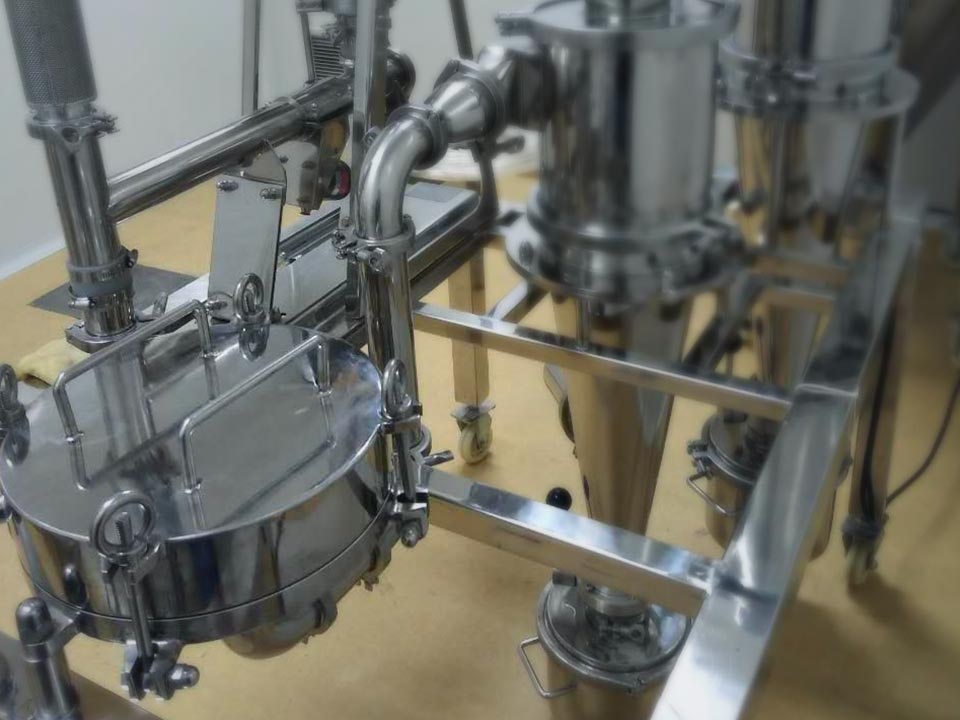
The characteristics of the API jet mill are:
1. This equipment is made of stainless steel 316 and stainless steel 304.
2. The inside of the equipment is finely polished 0.25-0.5 microns to meet the polishing requirements of different parts.
3. All equipment adopts quick pipe clamp interface connection, which is easy to disassemble and install, and easy to clean.
4. The equipment adopts movable casters, which is easy to move.
5. Except for the feeder, this equipment does not require electricity for other parts, and can be produced only by providing compressed air.
6. The equipment processing capacity is 0.5-30kg/h.
7. The finest pulverization fineness d100<3 microns.
8. It can solve the problems of sticking and blocking of viscous materials and strong static materials.
9. The equipment is airtight, there is almost no loss of raw materials, and the collection rate is high; the equipment has good airtightness, no leakage, and little damage to operators.
10. The equipment has low operating noise. Under normal production conditions, the equipment noise is very low, less than 63dB.
11. The raw materials produced can be directly connected to the packaging bag according to the requirements, which can avoid the leakage caused by the transfer process of the raw materials from the tank to the packaging bag, and avoid the damage to the human body and the leakage loss of the sticky wall of the material.
12. Compared with other equipment, the jet mill has lower energy consumption and smaller nozzle aperture.
13. It can provide a crushing cavity with a very narrow particle size distribution.
14. According to requirements, different Laval nozzles can be provided with different spray angles.
15. The crushing pressure can be up to 1.6Mpa.
16. There is no back-blowing phenomenon, our crushing disc pressure and feeding pressure, no matter which pressure is high, there will be no back-blowing phenomenon.
The jet mill classifier strictly controls the morphology, particle size and purity of the carbon powder
Toner, also called toner, is a powdery substance used to fix images on paper. In response to different needs, the production of toner is developing in the direction of refinement, colorization and high speed. Toner powder manufacturing mainly adopts pulverization method and polymerization method, and the pulverization method is widely used in the carbon powder processing industry. Compared with other crushing equipment, the product morphology, particle size distribution, purity, etc. obtained by using the jet mill has obvious advantages. It is one of the few domestic equipment that can process color consumable powder.
The standard configuration of the jet pulverization and classification production line is a combination of a fluidized bed jet pulverization host and a turbo classifier (an additional classifier will be added when high requirements are required). The particle size distribution is strictly controlled to ensure a qualified collection rate and yield. The complete production line has mature technology, stable equipment performance, constant operating parameters and reliable quality.
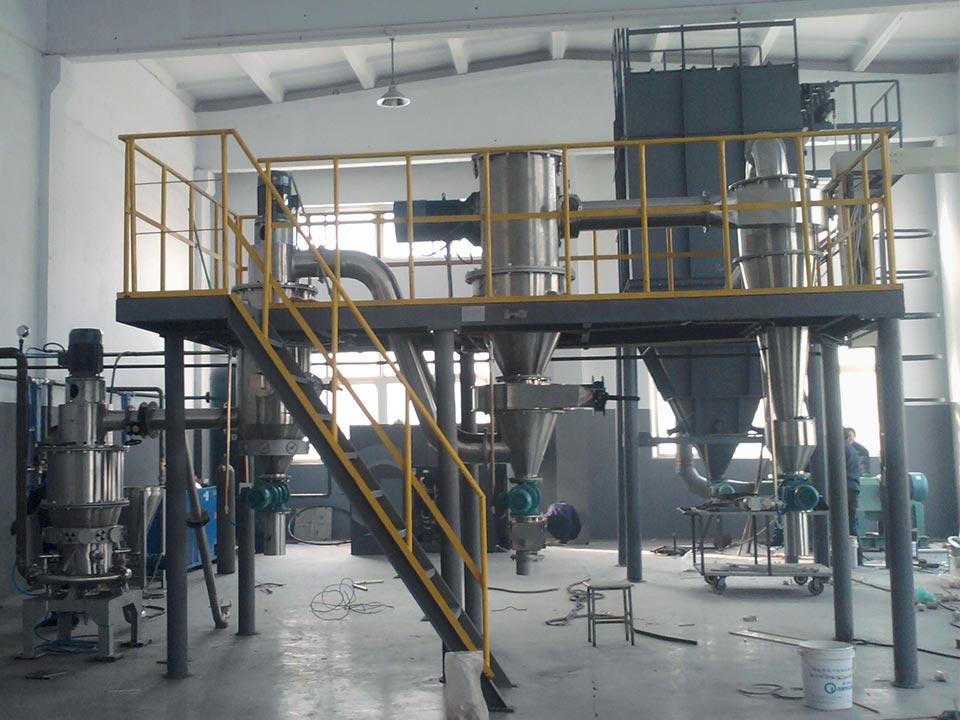
Features
- The jet pulverizer classifier can efficiently and accurately process high-quality toner for laser printer copiers.
- The complete and stable flow field established by multiple high-efficiency and high-precision classifiers in series strictly limits the generation of large particles, obtains an excellent particle size distribution and a very narrow particle size range, and can control the particle size of the product within a specific range.
- The control of pulverization strength and the technology of high-efficiency grading ensure a higher yield. The yield of black powder is more than 80%, and the yield of color powder is more than 70%.
- The effective application of particle shape control technology can obtain a better product shape.
- Once the operating parameters of the equipment are adjusted and fixed, the operation is stable, and there is no difference or change in the long-term continuous startup.
- Fully enclosed negative pressure operation, low-temperature crushing, high-purity operation, no dust pollution, system emission <5mg/m3.
- Equipped with a cyclone collector, the separated waste can be reused, reducing production costs.
Laboratory jet mill runs under full negative pressure, no dust pollution
The laboratory jet mill is a kind of small crushing equipment developed and produced for universities, research institutes, and small processing companies. The laboratory jet mill has the characteristics of high crushing accuracy, accurate classification, and the whole machine is small and easy to operate.
The laboratory jet pulverizer is composed of a pulverizing host, a classifier, a cyclone separator, and a pulse dust box. The materials enter the crushing chamber from the feeding hopper, and the materials are blown by high-speed airflow to make them collide and rub each other to be crushed. The distance between the grading knife and the grading disc is adjusted to achieve the required fineness. The crushed material enters the cyclone separator under the action of centrifugal force and the induced draft fan, and then is discharged through the fan induced air, and the dust enters the pulse dust collector, and is recycled after being filtered by an anti-static dust bag. The machine is designed according to the "GMP" standard. The whole machine is made of 304 stainless steel. It runs under full negative pressure, and there is no dust during the crushing process.
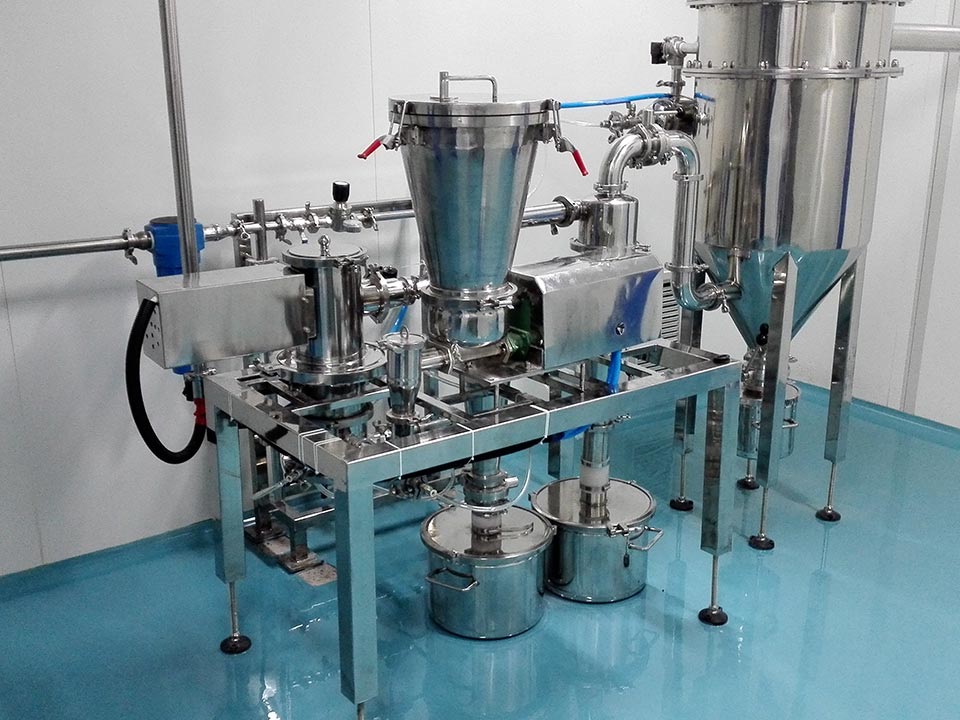
The laboratory jet mill also has the following performance advantages:
- It is used for small batch processing in the laboratory, the minimum feeding amount is about 500g;
- The granularity of crushing and classification can be adjusted arbitrarily from D50:1~45μm;
- Frequency conversion control, stable fineness and continuous work;
- Quick installation connection, easy to disassemble, easy to clean, no dead angle;
- The crushing process does not heat up, no impurities are mixed, and the noise is low;
- Small footprint and beautiful appearance;
- Good sealing, no dust, and small loss;
- It can flexibly realize the integration of jet smashing, jet grading, and mechanical smashing;
- The rotor of the horizontal high-efficiency classifier can reach 18,000 rpm;
- The mobile mechanical crusher unit is extremely convenient to disassemble and assemble;
- The mechanical pulverizer can realize full ceramicization;
- It can realize inert gas circulating atmosphere and powder classification of flammable and explosive materials;
- The sintered plate filter and dust removal unit can be selected, and the filter accuracy can reach 0.1μm99.9.
Jet mill achieves a breakthrough in the grinding of lithium battery materials
Lithium iron phosphate is a new type of lithium-ion battery electrode material. The ultrafine jet mill can pulverize lithium iron phosphate to 1-5 microns and achieve precise classification.
The lithium iron phosphate ultra-fine jet pulverization production line is a special production line specially developed for lithium iron phosphate pulverization according to the needs of the manufacturer and the problems encountered in the production and treatment of lithium iron phosphate. This production line is a closed cycle system that uses high-temperature dry nitrogen. , A device for simultaneous ultra-fine grinding and drying of lithium iron phosphate; the sintering system, crushing system, and packaging system for producing lithium iron phosphate are fully enclosed. Lithium iron phosphate is enclosed and transported during the sintering, crushing, packaging and other processes; the crushing system uses high-temperature dry nitrogen as the crushing gas source to dry the lithium iron phosphate instantaneously, and the lithium iron phosphate crushing and drying are carried out at the same time. This system solves the problem of continuous drying of phased products in the production process of lithium iron phosphate, saves energy and reduces production costs.

The new type of lithium iron phosphate ultrafine jet pulverization production line is a dedicated production line system that integrates high-temperature nitrogen protective jet pulverization and drying systems. Using high-temperature dry gas, while ultra-fine grinding of lithium iron phosphate cathode material for lithium batteries, supersonic airflow rotary jet flow field is used to conduct heat and mass transfer and instantaneous drying of the surface water of the material to achieve ultra-fine grinding of lithium iron phosphate. +Integration of trace moisture drying. When the feed moisture is 3000PPM and the feed particle size d50=20-30μm, the finished product particle size d50=0.6-2μm, d100=4-10μm, and the finished product moisture 200-500PPM after the integration of crushing and drying. Taking the production line with an annual output of 3000T as an example, the energy consumption per ton is 650-900 yuan/T, and the nitrogen consumption is 410-600Nm3/h. Compared with the traditional double-cone drying or roller furnace drying and ultra-fine grinding process, it saves 4.5-5.5 million yuan in energy consumption every year. At the same time, the ultra-fine pulverization and drying process realizes a fully closed-circuit air conveying system, which produces no dust pollution throughout the process. This process realizes the effective combination of lithium iron phosphate ultrafine grinding technology and ultrafine particle surface trace moisture control technology, and effectively solves the current problems that restrict the service life and safety of lithium batteries. It is lithium iron phosphate ultrafine powder for lithium battery cathode materials. A major breakthrough in the field of body preparation.
Various types and models of ultra-fine jet mills, classifiers, and crushing production lines are suitable for rare earth, mining and metallurgy, chemical, energy, medicine, feed, food and other industries. Whether the processed materials are ore, rare earths, non-ferrous metals, plastics, medicinal materials, agricultural products, or flammable, explosive, and oxidizable materials, it can meet your requirements on the particle size, output, and energy consumption of the finished product.
Air classifier can classify particles of various shapes
Air classifier is a kind of fine powder screening equipment, it is a kind of non-screen type classification equipment. Compared with screen type, air classifier is more in line with the requirements of today's environmental protection, and can be dust-free and stain-free during processing. And because it has no screen, it can effectively avoid the phenomenon of material blocking and adhesion, and can also ensure the purity of the raw materials.

The airflow classifier can classify spherical, flake, and needle-shaped particles, and can also classify particles of different densities. It has a wide range of applications, covering almost all areas of dry fine powder, such as metal powder, alloy powder, mineral powder, battery materials, ceramic powder, rare earth, etc. The wide application range of the air classifier benefits from its following performance advantages:
- It is suitable for the fine classification of dry micron products. It can classify spherical, flake, and needle-shaped particles, and can also classify particles of different densities.
- The particle size of the classified products can reach D97: 2~45 microns, the product particle size is adjustable, and the variety is extremely convenient to change.
- The classification efficiency (extraction rate) is 60% to 90%, and the classification efficiency of materials with good fluidity is high, otherwise the efficiency is reduced.
- The vertical grading turbine device is adopted, which has low speed, wear resistance and low system power configuration.
- It adopts horizontal grading turbine device with high speed and accurate apex cutting.
- Multi-stage classifiers can be used in series to produce products with multiple particle sizes at the same time.
- It can be used in series with ball mills, vibration mills, Raymond mills and other grinding equipment to form a closed loop.
- The control system adopts program control, the running status is displayed in real time, and the operation is simple and convenient.
- The system operates under negative pressure, and the dust emission does not exceed 40mg/m³, and the equipment noise is not higher than 75dB(A) through the use of silencer measures.
The performance advantages of jet mills can replace most mechanical pulverizers
Due to the widespread nature of industrial production, with the rapid economic development, jet mills have developed rapidly. In the scientific research and development process of powder production, application and equipment manufacturing, new equipment and new products are constantly appearing on the market. Jet mill is one of many crushing equipment.
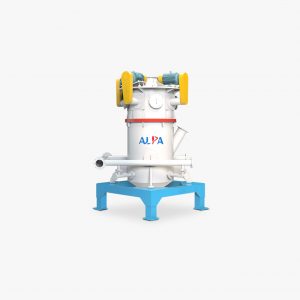
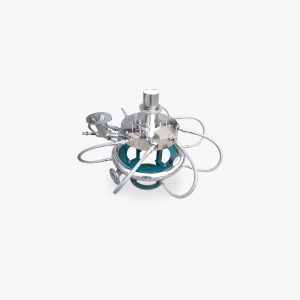
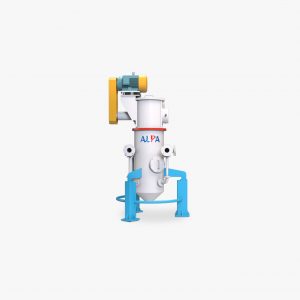
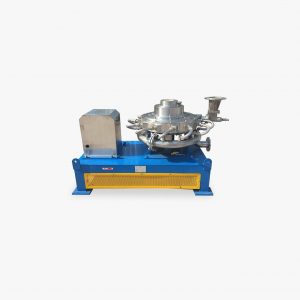
Jet mill is different from other pulverizers. It is under the action of high-speed airflow, the material is crushed by the impact between the particles of the material, the airflow impacts the material and the impact, friction, and shear of the material and other parts. Therefore, the average particle size of the material after airflow pulverization is fine, the particle size distribution is narrow, the particle surface is smooth, the particle shape is regular, the purity is high, the activity is high, and the dispersibility is good; With compressed air as the power, the adiabatic expansion of the compressed gas at the nozzle will reduce the temperature of the system). And if N2, CO2 and other gases are used, it can be crushed in an inert atmosphere under special occasions.
Jet pulverization can be operated under aseptic conditions; the production process is continuous, the production capacity is large, and the degree of self-control and automation is high. However, the production cycle of crushing equipment such as mechanical impact mills, vibration mills, and stirring mills is often long, resulting in low production efficiency; a large amount of heat is generated when the materials are crushed, which causes the deterioration of heat-sensitive materials; and the wear of the equipment will contaminate the products. . Therefore, these mechanical pulverizers can no longer fully meet people's increasingly high requirements for ultra-fine powder materials. Jet pulverization equipment has a tendency to replace mechanical pulverizers in the production of ultra-fine powder. Since the advent of the jet mill in the 1930s, through the efforts of many researchers, its structure has been continuously updated and the types have continued to increase. Fluidized bed jet mill, target jet mill, supersonic jet mill, etc.
There are many types of ultra-fine jet mills with different structures, and each model has its advantages and disadvantages. In recent years, the crushing equipment has been greatly improved on the basis of the previous, its structure has been continuously improved, and the crushing performance has been continuously improved. In order to meet the higher requirements of the development of information technology, biotechnology and new material technology on the particle size, purity and particle size distribution of powder products, the research of ultrafine jet pulverization technology should focus on the development of the following aspects: To improve and optimize ultra-fine jet mill equipment, develop new equipment, and pay attention to the matching design of pulverization and classification systems; there are not many large-scale equipment. In the above-mentioned ultra-fine jet mill, in comparison, the fluidized bed collision type Jet mill has obvious advantages, so theoretical research should be strengthened to guide the design of crushing equipment; since the biggest disadvantage of jet mill is low energy utilization rate, ways to reduce energy consumption and increase energy utilization rate should be sought.

